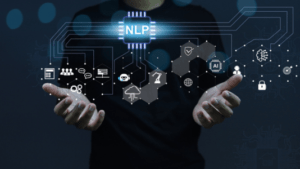Table of Contents:
1.1 Overview of Blockchain Technology
- 1.2 Significance of Blockchain in Software Development
- 1.3 Objectives of the Article
Blockchain Fundamentals for Software Developers
- 2.1 Understanding Blockchain Architecture
- 2.2 Consensus Mechanisms
- 2.3 Smart Contracts: The Building Blocks of Blockchain Applications
- 2.4 Public vs. Private Blockchains
- 2.5 Interoperability and Scalability Challenges
Applications of Blockchain in Software Development
- 3.1 Smart Contracts: Automating Business Processes
- 3.2 Decentralized Applications (DApps): Empowering Users
- 3.3 Supply Chain Management: Enhancing Transparency and Traceability
- 3.4 Identity Verification: Strengthening Digital Identity Systems
- 3.5 Data Privacy: Protecting Sensitive Information
Benefits and Advantages of Blockchain in Software Development
- 4.1 Enhanced Security and Data Integrity
- 4.2 Transparency and Auditability
- 4.3 Improved Efficiency and Cost Reduction
- 4.4 Eliminating Middlemen and Intermediaries
- 4.5 Enhanced Trust and User Empowerment
Challenges and Limitations of Blockchain in Software Development
- 5.1 Scalability Concerns and Performance Issues
- 5.2 Regulatory and Legal Implications
- 5.3 Integration with Existing Systems
- 5.4 Energy Consumption and Environmental Impact
- 5.5 User Adoption and Education
Future Trends and Advancements in Blockchain Technology
- 6.1 Blockchain Interoperability and Cross-Chain Communication
- 6.2 Integration of Artificial Intelligence and Machine Learning
- 6.3 Enhanced Privacy and Confidentiality Solutions
- 6.4 Blockchain as a Service (BaaS) and Cloud Integration
- 6.5 Integration of Internet of Things (IoT) and Blockchain
Case Studies: Real-World Examples of Blockchain in Software Development
- 7.1 Ethereum: The Platform for Decentralized Applications
- 7.2 Hyperledger Fabric: Enterprise-Grade Blockchain Solutions
- 7.3 VeChain: Revolutionizing Supply Chain Management
- 7.4 Sovrin: Self-Sovereign Identity on the Blockchain
- 7.5 Brave Browser: Privacy-Preserving Web Browsing
Conclusion
- 8.1 Recap of Key Findings
- 8.2 Future Outlook and Implications
- 8.3 Call to Action for Software Developers
- 8.4 Final Thoughts and Closing Remarks
Introduction
1.1 Overview of Blockchain Technology
Blockchain technology is a distributed ledger system that enables the secure and transparent recording of transactions. It operates on a decentralized network of computers, known as nodes, which work together to validate and record transactions in a chronological and immutable manner. The technology gained prominence with the emergence of cryptocurrencies like Bitcoin, but its potential extends beyond financial applications.
1.2 Significance of Blockchain in Software Development
In software development, blockchain has the potential to revolutionize various industries by providing decentralized and secure solutions. By eliminating the need for intermediaries and enabling trustless interactions, blockchain technology can enhance transparency, security, and efficiency. It offers programmable smart contracts, which automate business processes, and decentralized applications (DApps), which empower users with greater control over their data.
1.3 Objectives of the Article
The objective of this article is to explore the future of blockchain in software development. It aims to delve into the potential applications, benefits, and challenges associated with blockchain technology. Additionally, the article will discuss emerging trends and advancements that are likely to shape the future of blockchain in software development. By providing an in-depth analysis, software developers can gain insights into how blockchain can transform their work and contribute to a more decentralized and efficient digital landscape.
Blockchain Fundamentals for Software Developers
2.1 Understanding Blockchain Architecture
To harness the power of blockchain, software developers need to grasp its underlying architecture. Blockchain comprises blocks of data, which are linked together in a chronological and immutable chain. Each block contains a unique identifier, a timestamp, and a cryptographic hash of the previous block, ensuring data integrity and tamper resistance.
2.2 Consensus Mechanisms
Consensus mechanisms play a crucial role in ensuring agreement among nodes in a blockchain network. They determine how transactions are validated and added to the blockchain. Popular consensus mechanisms include Proof of Work (PoW), Proof of Stake (PoS), and Delegated Proof of Stake (DPoS). Each mechanism has its advantages and trade-offs, such as energy efficiency, security, and scalability.
2.3 Smart Contracts: The Building Blocks of Blockchain Applications
Smart contracts are self-executing agreements with predefined rules encoded on the blockchain. They automate business processes, eliminate the need for intermediaries, and ensure transparent and immutable execution. Smart contracts are written in programming languages specific to blockchain platforms like Solidity for Ethereum.
2.4 Public vs. Private Blockchains
Blockchain networks can be categorized as public or private. Public blockchains, such as Ethereum and Bitcoin, are open to anyone and offer high levels of decentralization and transparency. Private blockchains, on the other hand, restrict access to authorized participants, providing enhanced privacy and control. The choice of blockchain depends on the specific requirements of the software development project.
2.5 Interoperability and Scalability Challenges
Interoperability refers to the ability of different blockchains to communicate and exchange data seamlessly. Achieving interoperability is a challenge due to the fragmented nature of the blockchain ecosystem. Scalability is another concern, as the current design of some blockchains limits the number of transactions they can handle. Solving these challenges is crucial for the widespread adoption of blockchain technology in software development.
Applications of Blockchain in Software Development
3.1 Smart Contracts: Automating Business Processes
One of the primary applications of blockchain in software development is the automation of business processes through smart contracts. These self-executing agreements enable the transparent and secure execution of predefined actions when certain conditions are met. Industries such as finance, supply chain management, and real estate can benefit from the automation, accuracy, and efficiency provided by smart contracts.
3.2 Decentralized Applications (D Apps): Empowering Users
Decentralized applications (D Apps) leverage blockchain technology to create user-centric platforms that prioritize data privacy, ownership, and control. D Apps operate on a peer-to-peer network without the need for intermediaries, allowing users to interact directly with one another. They offer enhanced security, censorship resistance, and user empowerment, making them suitable for various domains, including social media, gaming, and finance.
3.3 Supply Chain Management: Enhancing Transparency and Traceability
Blockchain technology can revolutionize supply chain management by providing a transparent and immutable record of every transaction and movement of goods. By recording the entire supply chain journey, blockchain enables enhanced traceability, authenticity verification, and efficient management of inventory. This transparency builds trust among stakeholders and helps combat counterfeit products and fraudulent activities.
3.4 Identity Verification: Strengthening Digital Identity Systems
Traditional identity verification processes are often cumbersome and prone to security breaches. Blockchain technology offers a solution by enabling self-sovereign identity systems. These systems allow individuals to maintain control over their digital identities, ensuring privacy, security, and the ability to selectively disclose personal information. Blockchain-based identity verification can have significant applications in areas such as finance, healthcare, and voting systems.
3.5 Data Privacy: Protecting Sensitive Information
Data privacy is a growing concern in the digital age. Blockchain technology provides an opportunity to enhance data privacy by enabling encrypted and decentralized storage solutions. With blockchain, users can have greater control over their data and choose how and when to share it. Additionally, blockchain-based data marketplaces can empower individuals to monetize their data while ensuring their privacy and consent.
Benefits and Advantages of Blockchain in Software Development
4.1 Enhanced Security and Data Integrity
Blockchain offers robust security features through its decentralized and tamper-resistant nature. Transactions recorded on the blockchain are immutable and cryptographically secured, making it extremely difficult for malicious actors to tamper with the data. This feature enhances data integrity, reduces the risk of fraud, and strengthens cybersecurity.
4.2 Transparency and Auditability
Blockchain’s transparent nature enables anyone to view the recorded transactions, fostering trust and accountability. This transparency can be leveraged to improve auditing processes, regulatory compliance, and dispute resolution. With blockchain, stakeholders can easily trace the history of transactions, ensuring accountability and reducing the need for intermediaries.
4.3 Improved Efficiency and Cost Reduction
By automating processes through smart contracts, blockchain technology eliminates the need for manual intervention and reduces the associated costs and errors. Blockchain can streamline complex workflows, simplify reconciliation, and accelerate transaction settlements. These efficiencies can lead to cost savings for businesses and provide a better user experience.
4.4 Eliminating Middlemen and Intermediaries
Blockchain technology has the potential to disrupt industries that rely heavily on intermediaries. By enabling peer-to-peer transactions, blockchain removes the need for intermediaries, reducing costs and increasing efficiency. This disintermediation can revolutionize areas such as financial services, supply chain management, and intellectual property rights.
4.5 Enhanced Trust and User Empowerment
Blockchain’s decentralized and transparent nature fosters trust among users. It eliminates the need to rely on centralized authorities for validation and verification, providing a peer-to-peer trust model. Users have greater control over their data and transactions, promoting user empowerment and sovereignty. This increased trust and empowerment can reshape digital interactions across various sectors.
Challenges and Limitations of Blockchain in Software Development
5.1 Scalability Concerns and Performance Issues
Scaling blockchain networks to handle a high volume of transactions remains a significant challenge. Current blockchain solutions face limitations in terms of transaction speed and scalability, often unable to match the transaction throughput of traditional centralized systems. Efforts are underway to address these challenges through innovations such as layer 2 solutions, sharding, and consensus algorithm enhancements.
5.2 Regulatory and Legal Implications
Blockchain technology raises complex regulatory and legal questions, particularly in areas such as data privacy, intellectual property, and jurisdictional issues. The decentralized nature of blockchain challenges traditional legal frameworks and poses difficulties in enforcing regulations. Striking a balance between innovation and compliance is crucial for the successful adoption of blockchain in software development.
5.3 Integration with Existing Systems
Integrating blockchain technology with existing legacy systems can be a complex task. Many organizations rely on established software infrastructures, and transitioning to blockchain requires careful planning and considerations. Interoperability challenges between different blockchains and compatibility with existing databases and applications pose obstacles that need to be addressed for seamless integration.
5.4 Energy Consumption and Environmental Impact
The energy consumption associated with certain blockchain consensus mechanisms, such as Proof of Work, has raised concerns regarding sustainability and environmental impact. The high computational power required for mining and validating transactions can result in substantial energy consumption. Efforts are underway to develop more energy-efficient consensus mechanisms and explore alternative approaches to mitigate the environmental footprint.
5.5 User Adoption and Education
Blockchain technology is still relatively new and unfamiliar to many users. Its complex concepts and technical nature present a barrier to widespread adoption. Overcoming this challenge requires educational initiatives to raise awareness, improve user understanding, and create user-friendly interfaces. Simplifying the user experience and providing intuitive tools and documentation will be key to driving adoption in software development.
Future Trends and Advancements in Blockchain Technology
6.1 Blockchain Interoperability and Cross-Chain Communication
Addressing the challenge of blockchain interoperability will be a significant focus in the future. Efforts are being made to enable seamless communication and data exchange between different blockchain networks, allowing for interoperability of DApps and facilitating the transfer of assets across multiple blockchains.
6.2 Integration of Artificial Intelligence and Machine Learning
The convergence of blockchain technology with artificial intelligence (AI) and machine learning (ML) holds immense potential. AI and ML algorithms can leverage the transparency and security of blockchain to enhance data analysis, automate decision-making, and improve the efficiency of processes. This integration can lead to innovative applications in areas such as healthcare, finance, and supply chain management.
6.3 Enhanced Privacy and Confidentiality Solutions
Blockchain platforms are evolving to address privacy concerns and enable secure and confidential transactions. Advancements in zero-knowledge proofs, homomorphic encryption, and privacy-focused consensus mechanisms aim to provide better privacy solutions without compromising the transparency and auditability of blockchain networks.
6.4 Blockchain as a Service (BaaS) and Cloud Integration
Blockchain as a Service (BaaS) platforms simplify the deployment and management of blockchain networks, making it easier for software developers to utilize blockchain technology. Integration of blockchain with cloud computing services enables scalable and flexible blockchain solutions, reducing the infrastructure and maintenance overheads associated with deploying blockchain networks.
6.5 Integration of Internet of Things (IoT) and Blockchain
The integration of blockchain with the Internet of Things (IoT) can unlock new possibilities in areas such as supply chain management, asset tracking, and data integrity. Blockchain can enhance the security, trust, and interoperability of IoT devices, enabling decentralized and autonomous IoT networks.
Case Studies: Real-World Examples of Blockchain in Software Development
7.1 Ethereum: The Platform for Decentralized Applications
Ethereum is a blockchain platform that revolutionized the development of decentralized applications. It introduced smart contracts, enabling developers to build DApps across various industries, including finance, gaming, and decentralized finance (DeFi).
7.2 Hyperledger Fabric: Enterprise-Grade Blockchain Solutions
Hyperledger Fabric is a permissioned blockchain framework designed for enterprise use cases. It provides a flexible and modular architecture, allowing organizations to tailor blockchain networks to their specific requirements. Hyperledger Fabric is widely adopted in industries such as supply chain management and healthcare.
7.3 VeChain: Revolutionizing Supply Chain Management
VeChain is a blockchain platform that focuses on supply chain management and product authenticity verification. It leverages blockchain technology to provide transparency, traceability, and trust in supply chains, enabling businesses and consumers to verify the origin and authenticity of products.
7.4 Sovrin: Self-Sovereign Identity on the Blockchain
Sovrin is a blockchain-based self-sovereign identity platform that empowers individuals to control and manage their digital identities. It provides a decentralized identity ecosystem, enabling secure and privacy-preserving digital interactions while eliminating the need for centralized identity authorities.
7.5 Brave Browser: Privacy-Preserving Web Browsing
Brave Browser is a privacy-focused web browser that integrates blockchain technology to enhance user privacy and rewards content creators. It utilizes the Basic Attention Token (BAT) to incentivize users and content creators, creating a more equitable and transparent online advertising ecosystem.
Conclusion
8.1 Recap of Key Findings
Blockchain technology has the potential to transform software development by providing decentralized, secure, and efficient solutions. It offers benefits such as enhanced security, transparency, efficiency, and user empowerment. Blockchain’s applications in smart contracts, decentralized applications, supply chain management, identity verification, and data privacy hold immense promise.
8.2 Future Outlook and Implications
The future of blockchain in software development is characterized by ongoing advancements and emerging trends. Interoperability, integration with AI and IoT, enhanced privacy solutions, and cloud integration are expected to shape the evolution of blockchain technology. These advancements will drive innovation and unlock new possibilities across industries.
8.3 Call to Action for Software Developers
Software developers should embrace blockchain technology as a disruptive force and explore its potential applications in their projects. By staying updated with the latest advancements, addressing challenges, and acquiring the necessary skills, developers can position themselves at the forefront of blockchain-driven innovation.
8.4 Final Thoughts and Closing Remarks
Blockchain technology holds the promise of a decentralized future, transforming how software is developed and deployed. By harnessing the power of blockchain, software developers can contribute to a more transparent, secure, and efficient digital landscape, unleashing the true potential of decentralization.



